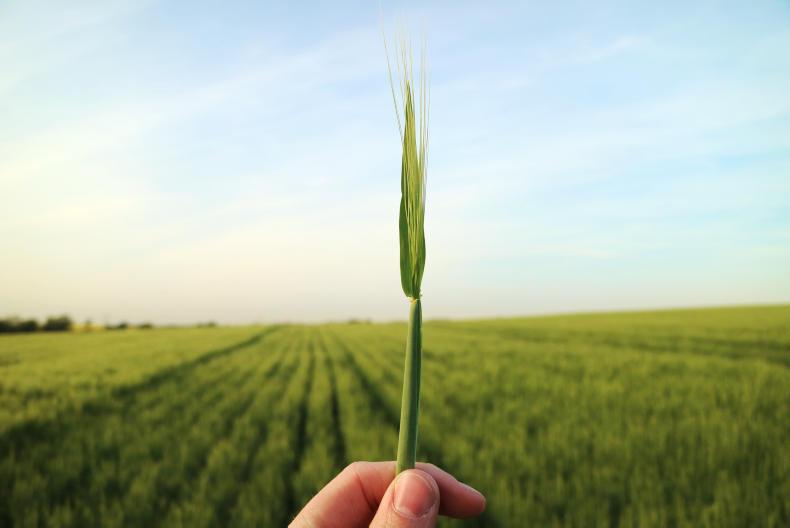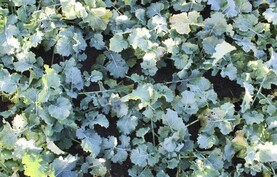Parts of the country received some rain today after a status yellow rain warning brought between 25mm and 35mm in places. However, many areas, particularly along the east coast, received little rain, which is paving the way for the final bits of sowing to take place. It now appears that the rest of the week will be dry and fine, which will pave the way for important crop husbandry jobs to be completed.
Spring crops
Nearly all cereals are sown at this stage, but this week really should be the deadline for sowing. Crops are ranging from emergance to tillering. Most later-sown crops were sown into relatively good seedbeds, but there are plenty of crops which were sown in moderate to poor ground. Crop conditions vary, with some cases of poor emergence reported. The final nitrogen top-dressing should now be applied on virtually all spring crops. Where required, apply sulphur.
Pests: Aphids are active, although cases of winged aphids are low. BYDV infection is a threat, so apply a pyrethroid insecticide at full rate at the four-leaf stage. Be conscious that the spring crops may not actually produce four leaves before tillering due to the short season. Ensure to monitor aphid numbers before and after spraying, as pyrethroid resistance is present.
There are also plenty of reports of weevil notching in spring beans. Where damage is very evident, consider an insecticide such as Decis, Karate, Karis or Lambda.
Weed control: Spraying early, at the three- to five-leaf stage is important for weed control in spring cereals. There has been good growing conditions of late, so weeds are at the right time for spraying. Herbicides should include an SU, or a mix of SUs, plus a contact or hormone partner.
Products such as Galaxy or Pixxaro might be considered, particularly where resistant weeds are a problem. Wild oats or canary grass may also be treated now with products such as Axial and/or Adigor.
Winter crops
Winter crop potential continues to look good and most are quite clean. However, septoria continues to present itself in winter wheat, while some yellow rust is also making an appearance.
Winter wheat continues to move towards flag leaf, with some crops now fully emerged. T2s will be applied on many crops this week. Flag leaf treatments should include an SDHI, triazole and multisite, such as Adexar, Ascra, Elatus Era, or Treoris, plus a triazole. Include chlorothalonil in all sprays and use a different triazole active at T2 versus T1.
Winter barley crops are at the awns-peeping stage and, for some, the head is now fully out. Head sprays should be applied when the awns are peeping. Waiting until the head is fully out will likely lead to a yield penalty. Barley is in flower as the head emerges, so it is important to protect these sites.
The final fungicide should be a good rate of a triazole, along with an SDHI or a strobilurin plus a contact fungicide (chlorothalonil or folpet) to help prevent ramularia. Product options include Siltra, Bontima, Ceriax, Elatus Era, a Treoris triazole mix, or Fandango, plus chlorothalonil or Phoenix.
Reminder
Remember, the deadline to amend land parcels on your BPS application is 31 May.
Read more
Spring planting drawing to a close
Good planting progress in places but many areas still damned by wet ground
Parts of the country received some rain today after a status yellow rain warning brought between 25mm and 35mm in places. However, many areas, particularly along the east coast, received little rain, which is paving the way for the final bits of sowing to take place. It now appears that the rest of the week will be dry and fine, which will pave the way for important crop husbandry jobs to be completed.
Spring crops
Nearly all cereals are sown at this stage, but this week really should be the deadline for sowing. Crops are ranging from emergance to tillering. Most later-sown crops were sown into relatively good seedbeds, but there are plenty of crops which were sown in moderate to poor ground. Crop conditions vary, with some cases of poor emergence reported. The final nitrogen top-dressing should now be applied on virtually all spring crops. Where required, apply sulphur.
Pests: Aphids are active, although cases of winged aphids are low. BYDV infection is a threat, so apply a pyrethroid insecticide at full rate at the four-leaf stage. Be conscious that the spring crops may not actually produce four leaves before tillering due to the short season. Ensure to monitor aphid numbers before and after spraying, as pyrethroid resistance is present.
There are also plenty of reports of weevil notching in spring beans. Where damage is very evident, consider an insecticide such as Decis, Karate, Karis or Lambda.
Weed control: Spraying early, at the three- to five-leaf stage is important for weed control in spring cereals. There has been good growing conditions of late, so weeds are at the right time for spraying. Herbicides should include an SU, or a mix of SUs, plus a contact or hormone partner.
Products such as Galaxy or Pixxaro might be considered, particularly where resistant weeds are a problem. Wild oats or canary grass may also be treated now with products such as Axial and/or Adigor.
Winter crops
Winter crop potential continues to look good and most are quite clean. However, septoria continues to present itself in winter wheat, while some yellow rust is also making an appearance.
Winter wheat continues to move towards flag leaf, with some crops now fully emerged. T2s will be applied on many crops this week. Flag leaf treatments should include an SDHI, triazole and multisite, such as Adexar, Ascra, Elatus Era, or Treoris, plus a triazole. Include chlorothalonil in all sprays and use a different triazole active at T2 versus T1.
Winter barley crops are at the awns-peeping stage and, for some, the head is now fully out. Head sprays should be applied when the awns are peeping. Waiting until the head is fully out will likely lead to a yield penalty. Barley is in flower as the head emerges, so it is important to protect these sites.
The final fungicide should be a good rate of a triazole, along with an SDHI or a strobilurin plus a contact fungicide (chlorothalonil or folpet) to help prevent ramularia. Product options include Siltra, Bontima, Ceriax, Elatus Era, a Treoris triazole mix, or Fandango, plus chlorothalonil or Phoenix.
Reminder
Remember, the deadline to amend land parcels on your BPS application is 31 May.
Read more
Spring planting drawing to a close
Good planting progress in places but many areas still damned by wet ground






 This is a subscriber-only article
This is a subscriber-only article















SHARING OPTIONS: